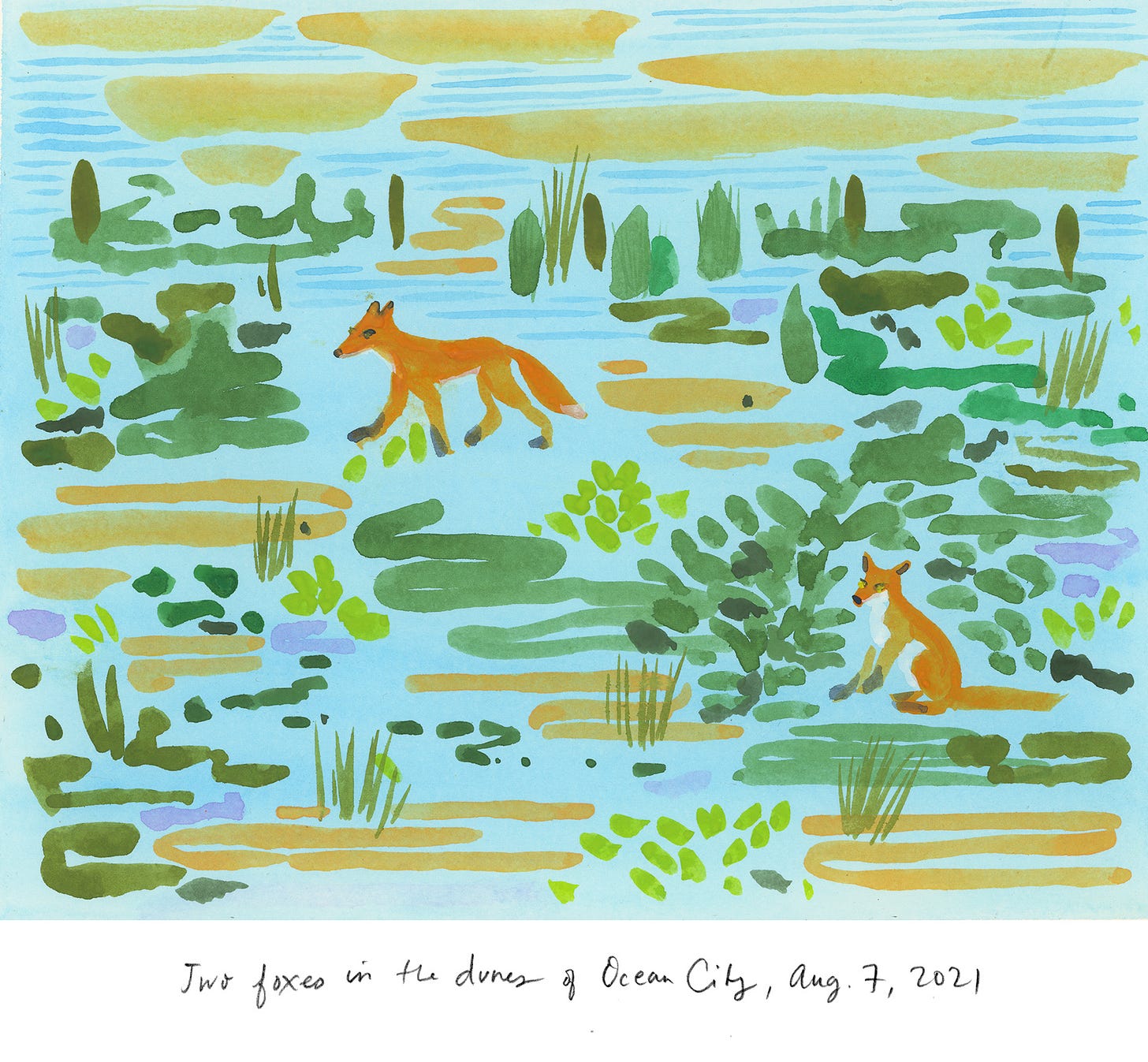Hi, friends — last week was a vacation week for me, so this newsletter is a little different than usual, venturing out of the woods for a moment. I hope everyone has a chance to take a break, or at least a deep breath, and enjoy the mid-August light. — Amy Jean
We were at the beach last week, in Ocean City, Maryland. I’d never been there before, and it’s on one of those long, skinny bits of land—a barrier island known as Fenwick Island. You can put your toes in the Atlantic, stretch your body across the highway, and touch the tips of your fingers to the bay (not really, but it kind of seems that way, if you were feeling particularly stretchy one day).
Ocean City is packed with people on a summer day, stacked in 10-story buildings, lined up under beach umbrellas, playing Spikeball near the waves. The island has been a resort destination since the 1870s and was once known as “The Ladies’ Resort to the Ocean.”
Storms and warming waters are constantly changing the movement of the sand, and every few years the seabed is dredged a few miles out and sand is brought in to replenish the beach. Thirty years ago, sand was brought in to create an almost 7-mile dune between the beach and the buildings. The long, skinny dune is now full of low shrubs, grass, and cacti, protected by a short, slatted fence.
We stayed at a friend’s condo on the third floor overlooking the ocean. Whenever I look at the ocean, I like to think about how out in the depths there are creatures that do not know we exist. Down in the dark, in the enormous deep, where possibly 80% of life on Earth exists, there are animals that do not know about the nearly 8 billion people up here.
Only a small fraction of the world’s oceans have been mapped. At the very edge of one, we hopped around in waist-crashing waves and got stung by the tapioca-sized larvae of jellyfish, caught in our swimsuits (more embarrassing than painful).
A rainstorm, which hadn’t seemed like much, tossed the ocean around enough to create true havoc in the form of rip currents and hard beach breaks. It spit up the body of a horseshoe crab. It was like finding a minibus on the beach—its carapace smooth and strong and very strange. Horseshoe crabs have been in the oceans for nearly half a billion years. I lifted up an edge to reveal its many skinny legs hanging limp like a beaded curtain.
Sometimes I wonder if humans are a slow-moving meteor, destined to change life on Earth in a painfully grinding way (though I suppose 6,000 years of human civilization is only a blip compared to half a billion years—maybe we are not so slow moving after all).
On the last day of our trip, looking out the window of our room, we noticed two red foxes scampering in the dunes. They were trotting playfully around each other, stepping atop the cacti no bother, sitting in the shade under a shrub, digging at a hole in the dunes. One of them came over near the edge of the building, clearly tracking something. I clicked my tongue and it gazed up at me. The fox and I looked at each other for a moment—oh, there you are.
The foxes breezed along the length of the dunes and no one on the beach could see them. Hundreds of thousands of people on this barrier island and two little foxes slipped by, unseen, because someone made a space for them. It felt promising to me. We could be smart, we could make room, we could be better than a meteor.
A small flock of sandpipers ran out as the waves retreated into the ocean, and then ran back up the beach as a new wave came in. Two dolphins surfaced for a breath beyond the tourist boats. The sky is different at every moment, the patterns repeat in variations. The Earth turns toward the sun every day.
Late-summer reading—
This article in the New Yorker has stayed with me, about Molly Burhans, who is using advanced mapping technology to determine corridors for wildlife, among other land management innovations: “How a Young Activist Is Helping Pope Francis Battle Climate Change.”
Margaret Renkl always puts things together in a sharp but gentle way, most recently in this opinion piece in the New York Times, “I Don’t Want to Spend the Rest of My Days Grieving.”
Animal encounters in recent comments—
You can still add to the Wild Life summer diary, or peruse other readers’ sightings of wildlife, here. I’ll keep this thread open through the end of August.
Also—
My fox drawing is for sale! Part of the proceeds will go to the Clean Air Task Force. Please let me know if you’re interested, or take a look here.
Next time: a little something from the river.
Wild Life #28 / this newsletter is a place to learn about the life around us, one small step/paw/tiny heartbeat at a time. If you enjoy reading, please share with a friend, neighbor, niece, nephew, cousin, sister, teenager. Have a great weekend, and I’ll be back in a couple of late-summer weeks.





Always a delight! Thank you Amy Jean Porter!
Amy Jean -- I just love the way you write. You're witty, observant, and wise. You can go from the particulars of your situation to what you see (wildlife, sea life, waves), to observations about men, the earth and the universe. I would like more.....